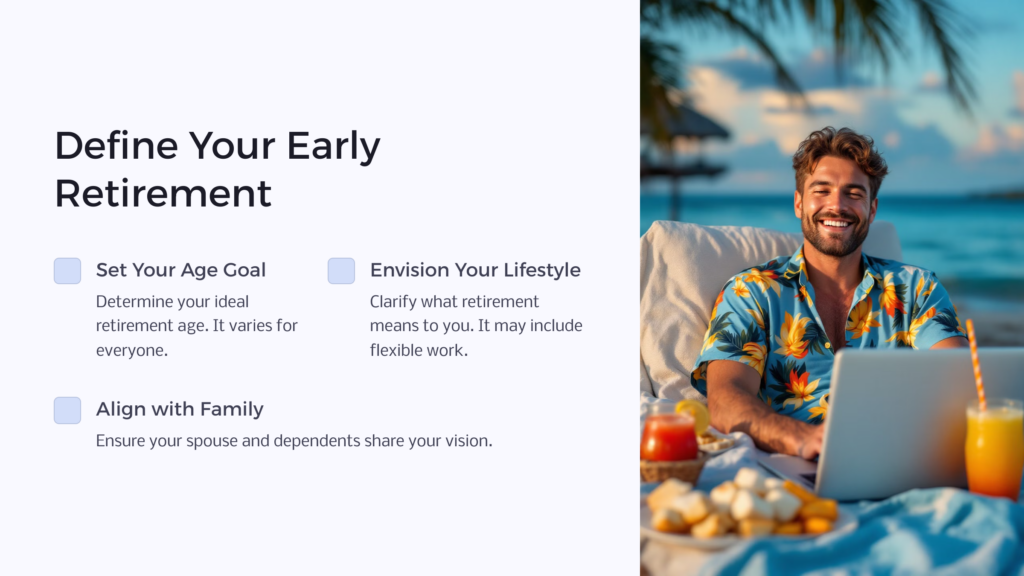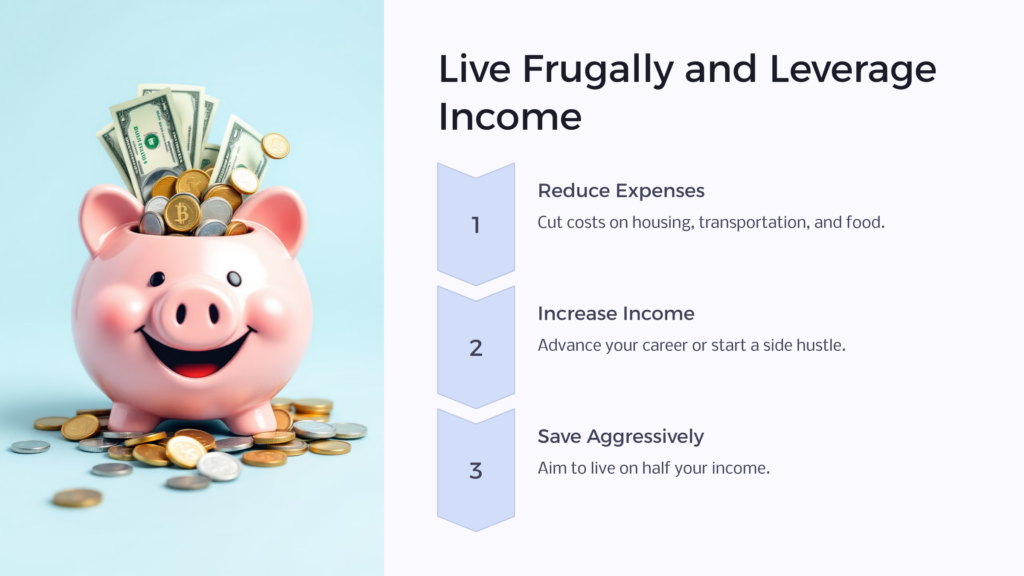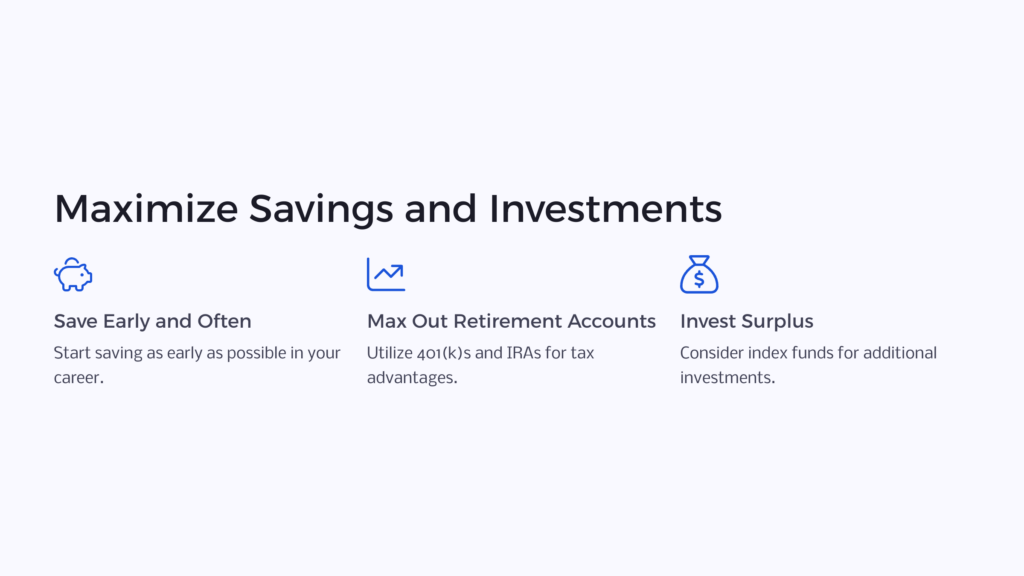Planning for early retirement is like planning for any kind of retirement – with the notable exception of the time variable. Working with a compressed time table means you make different choices in the short-term and may need to be more aggressive in your savings and investment efforts. Not only do you have less time to meet your retirement goals, but you also have more time to support yourself from your retirement preparations.
But that doesn’t mean it’s impossible – in fact, many people find success when it comes to retiring early. If you think retiring early is something you may have the interest and ability to do, keep reading. We’ll break down the steps you can start taking today to make sure you can exit the labor force on the deadline that makes the most sense for you.
9 Ways to Plan for Early Retirement
- Define early retirement
- Examine your finances
- Establish your goals
- Live frugally
- Leverage income
- Save early and frequently
- Eliminate debt
- Invest anything that’s left
- Define Plan B
Early retirement sounds like a dream come true – being able to walk away from the daily grind with financial independence while you’re still young and healthy enough to enjoy the benefits of being the master of your time. And while it might sound far-fetched to some, it isn’t impossible. Depending on where you are in your career, deciding early that you’d like to retire well before the full retirement age of 65 or 67 means that you can put some steps in place immediately to help make that dream a reality.
What Is the Early Retirement Age?
The Social Security Administration (SSA) defines early retirement as age 62, and full retirement age as 65 or 67, depending on the year you were born. That’s when an employee is expected to apply for and receive Social Security retirement benefits. However, you can apply for and begin receiving those benefits as early as age 62.
But what you gain in time you forfeit in your retirement benefit amount – for every month before age 67 that you receive a retirement benefit, your benefit amount is reduced 5/9 of 1%, up to 36 months. After 36 months, benefits will go down by another 5/12 of a percent per month.
If you begin receiving your social security benefit at age 62 and your normal retirement age is 67, your monthly benefit amount will be reduced by 30 percent overall. So it’s worth calculating whether you have other income, like a pension or a retirement portfolio, that you can draw from until at least age 67, or whether the reduced social security benefit, combined with your other retirement or pension plan, is sufficient for your annual expenses.
10 Ways to Plan for Early Retirement
There are several proactive steps you can take to make sure you’re ready to retire early.
Define Early Retirement

For some people, “early retirement” might mean leaving the labor force at age 45, while for others it means retiring at age 60. Before you start any kind of planning or preparation, make sure you – and your spouse and/or dependents – are completely clear on what your early retirement date looks like. Just exactly what age would you like to be when you retire? Even a five-year difference can have a hefty financial impact.
Besides the age, you also should be clear about what you mean by, “retirement.” For many who choose to retire early, being retired doesn’t mean never earning another paycheck. But it may mean leaving a structured, 9-5 position for something more flexible or creative, or simply something that allows more time and opportunity for outside interests.
When and how to retire is a very personal decision, so take the time to think about what you’d like retirement behavior to look like for you. When you know that specific target, the best plan becomes clearer and more straightforward.
Examine Your Finances

The first start in retirement planning is figuring out where you are today. First, what’s your net worth? And, second, what are your spending habits? How robust is your emergency fund? This may take some time, but you can add up all your assets and expenses to see the relationship between the two. Knowing exactly where you stand financially can help you move on to the next step, which is setting the financial goals that will make early retirement a reality.
Establish Your Goals
The important next task is to calculate how much money you’ll need to have saved to cover annual spending once you start your retirement. This is where you can benefit from the expertise of a financial planner to help you plan for various scenarios. Ultimately, there’s no one “right” way to set a financial goal since it will be so tied to your personal preferences and habits. But it is important to set a goal – you can always adjust it as time goes on.
In addition to basic living expenses, also think about your health insurance needs. Health care costs can make up a huge chunk of expenses after retirement, so if you’re retiring before Medicare kicks in at age 65, you’ll need to be prepared to lose your employer-sponsored health insurance plan. For example, if your spouse continues to work, you may consider joining that plan. Or you can purchase insurance from a former employer through COBRA, or you may consider working with an insurance broker to find a private policy for you. Just make sure you address the issue so that your health insurance needs can continue to be met after retirement.
Live Frugally

If you’re in the habit of spending more than you earn, chances are you’ll find it very difficult to save enough money over time to retire significantly early. Many experts agree that the only way to save and invest aggressively for early retirement is to live well within your means – and then put the excess toward your retirement portfolio. Take a good, hard look at your current expenses and ask yourself what you can afford to live without to achieve your longer-term goal of being able to retire early. What’s usually most helpful is reducing your largest expenditures, which tend to be housing, transportation, and food, so start there first to see where you can reduce some expenses. Many people who are working hard to retire early have set a budget that allows them to live on just half their income – if you can do that, you can dramatically increase your savings rate.
Leverage Income
Working hand in hand with decreasing expenses is increasing your income. While cutting expenses can be an effective short-term solution to saving, increasing your income over the life of your career continues literally to pay over your lifetime – and may help open the door to early retirement. You can do this in a few different ways – you can continue to pursue education, experience, and credentials that help you advance within your career, you can start a side hustle to diversify your income stream, and you can even pursue a passive income strategy, like real estate, for example, to vary where your income comes from and how much you’re able to save now.

Save Early and Frequently
If there’s a common thread that runs among all approaches to retiring early, it’s this one: Start saving as early in your work life as you can, and save at every opportunity you get. You can start by maxing out your retirement account(s) – whether you’re saving through an employer-sponsored retirement plan, an IRA or some combination of the two, they’ll offer you tremendous tax savings today, along with a chance to build a substantial nest egg for early retirement tomorrow.
Just make sure you’re aware of all the rules and restrictions around accessing your money early. If you begin withdrawing from a 401(k) retirement account before you reach the age of 59 1/2, you’ll have to pay penalties. But – if you’re withdrawing from a Roth IRA, which is funded with after-tax earnings, you can withdraw contributions (not earnings) at any time without paying penalties or taxes. You’ll need to factor those restrictions into your income calculations for post-retirement life.
Eliminate Debt
You shouldn’t consider retiring early if you’re still saddled with a hefty mortgage or with credit card or other high-interest consumer debt. Factor paying off your house and other debts into your plan for preparing to retire early. In addition to the financial freedom this move provides, many early retirees say that it also contributes to a psychological sense of freedom and the ability to enjoy yourself in your early retirement.
Invest Anything That’s Left
Let’s say you’re maxing out your available retirement account options and still have some surplus that you could save. You can take that surplus and invest it in a brokerage account, which lets you invest money in the stock market and withdraw it whenever you need it. Index funds are often a good investment here – they help minimize your investment risk by offering an all-in-one investment that tracks a particular market, diversifying your investments. Many early retirees swear by this investment approach.
Define Plan B
No plan is ever foolproof – it’s a good idea to plan for something to go wrong. This is another place where it might be good to work with a financial advisor to prepare for all possible worst-case scenarios, including everything from a tanking economy to the possibility that you’ll prefer working after retirement.
What Is the 4% Rule?
The 4% Rule is a commonly cited rule of thumb when it comes to determining how much income you’ll need during retirement. In general, the principle says you need to make sure that you have enough in your retirement savings and investments to meet all your needs without withdrawing any more than 4 percent of the total each year. This model, which was based on 50 years’ worth of data about stock and bond returns, aims to provide a retiree with a steady income stream while also making sure to conserve enough of a principal balance to keep that stream of income flowing throughout someone’s retirement years.
While the 4% Rule has been widely accepted wisdom for some time, don’t necessarily take it as gospel without doing your own research. Since life expectancy plays a huge role in how long you’ll need to access your retirement income, if you want to retire early, you should talk with your financial planner about whether the 4 percent rule makes sense for you.
Planning for Early Retirement

When all else is said and done, the combination of time, knowledge, and discipline can make it possible for you to become an early retiree – whatever that means to you. Once you’ve taken the time and effort to define your current circumstances, set specific goals and identify the steps to get you there, it’s just a question of sticking to your plan and adjusting it as necessary until you reach your goals. While most financial planners will agree on the wisdom of living frugally and saving and investing aggressively, many will also agree that it’s unwise, both mentally and fiscally, to live only for the future. Don’t forget also to enjoy today – build in modest splurges and rewards along your way to your major goals.
 Benefits.com Advisors
Benefits.com Advisors
With expertise spanning local, state, and federal benefit programs, our team is dedicated to guiding individuals towards the perfect program tailored to their unique circumstances.
Rise to the top with Peak Benefits!
Join our Peak Benefits Newsletter for the latest news, resources, and offers on all things government benefits.



















